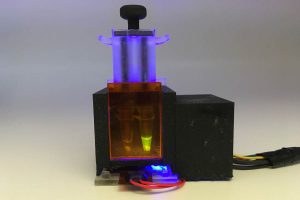The Defense Advanced Research Projects Agency (DARPA) has teamed up with Massachusetts-based Draper to streamline the design of microbe-based electronic sensors. “Microbes have the potential to be developed as biological sensors that can collect vital information about the environments they naturally inhabit,” said Draper biotechnologist Chris Vaiana. “Our goal is to support DARPA in mapping the modular design of microbe-based ...
Tag Archives: MIT
Elastomer engineering finally gets deep images from skin patch ultrasound
Engineers at MIT have found a way to get sub-mm resolution and deep penetration from a stick-on ultrasound patch that can be worn for at least two days and peels off at the end of monitoring without leaving residue. In a proof-of-concept, they demonstrated sub-mm resolution images in the first centimetres of tissue, allowing blood vessels to be monitored live, ...
Portable MIT desalinater makes drinking water for 20Wh/litre
Researchers at MIT have produced a prototype water purifier that can turn cloudy seawater into drinking water using ~20Wh/litre. Developed under electrical engineer Professor Jongyoon Han, the unit fits into a small suitcase, and relies on multiple stages of ‘ion concentration polarisation’ (ICP), followed by electrodialysis to reduce residual salt concentration. ICP, pioneered by Han’s group, applies an electrical field to ...
Thermo-electric generator is 40% efficient, but only at 1,900-2,400°C
MIT has created a thermovoltaic demonstrator that can convert heat energy at between 1,900 and 2,400°C in to electricity energy with 40% efficiency – which is above that of a steam turbine. The technology is aimed at future grid-scale energy stores. Analagous to a multi-junction photovoltaic cell, MIT’s device has two stacked junctions, each picking up part of the incident ...
Sludge-like fluid might lead to grid-scale flow batteries
Flow batteries show promise for grid-scale storage as, like fuel cells, they decouple power output and energy storage when building a battery: the reactor is sized for power output and the surrounding tanks are sized for energy capacity. Given a low-cost working fluid and big tanks, they could store enormous amounts of energy. Seeking that low-cost fluid, MIT is proposing to ...
Gadget Book: Living with Robots – What Every Anxious Human Needs to Know
This book sounds like a good, worthwhile read. It's from MIT Press and is called Living with Robots: What Every Anxious Human Needs to Know.
Low-cost device engineered for 1 hour Covid variant test
Harvard and MIT researchers have teamed up to prototype a self-contained saliva-based diagnostic Covid test that can distinguish between variants in an hour and is “just as accurate as the PCR tests now used”, according to MIT. It is called ‘miSherlock’, for ‘minimally-instrumented Sherlock’, where Sherlock is a Crispr-based DNA/RNA test invented at Harvard’s Wyss Institute for Biologically Inspired Engineering. Two ...
Tracker Capital gives boost to Accion spacecraft propulsion
Accion Systems, the spacecraft propulsion specialists spun out of MIT, has announced $42 million in Series C funding led by an affiliate of Tracker Capital Management. The investment both brings Accion Systems’ valuation to $83.5 million and means that the New York-based investor has acquired a majority stake in the company. The investment will support the company’s development of its ...
UV modulation by twisting crystal films
Films of the two-dimensional material hexagonal boron nitride can be used to control light emission from materials, according to the Singapore-MIT Alliance for Research and Technology (Smart). The phenomenon involves the creation of ‘Moiré superlattices’ as two films are rotated with respect to one-another, and works at room temperature with films made from stacks of atoms around 100nm high – considered bulk materials ...
ISSCC 2021: MIT links silicon chips at 100Gbit/s with dielectric ribbon
In a silicon-compatible parallel to fibre optics, MIT is using polymer-based ribbon waveguides to carry data between chips at 105Gbit/s – waveguide dimensions and material are chosen so that it propagates electromagnetic radiation between 200 and 335GHz, over 300mm of waveguide. To handle suitable sub-Thz frequencies, transmitter and receiver were made on a 130nm SiGe BiCMOS process using largely bipolar transistors in ...
 Electronics Weekly Electronics Design & Components Tech News
Electronics Weekly Electronics Design & Components Tech News








